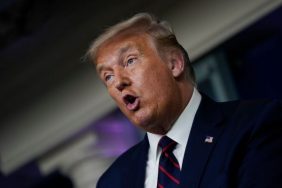As you walk the length of the Geffen Contemporary at MOCA, located in downtown Los Angeles’ Little Tokyo district, and you make your way to the entrance, you hear what sounds like a massive airplane engine running inside the building. It’s a heavy, dense, industrial sound. After entering and then stepping into the heart of the space, the source of the sound is located: the large-scale industrial fans that continuously blow air, creating forceful interior winds to keep the giant custom-made American flag (54 x 16 feet) flapping in the air.
Related: God Is Love: The Story Of Leonard Knight and Salvation Mountain
The installation is titled Trinket, and it’s just one part (the centerpiece, actually) of the current exhibition of new works by critically acclaimed visual artist William Pope L. Trinket is breathtaking. Fellow museum goers stand mesmerized before whipping out their cameras and filming the politically charged spectacle.
The piece came to mind in the wake of the hoopla that surrounded Hilary Clinton’s announcement of her plan to run for president (i.e., that she would be claiming her seat on the Bush/Clinton legacy merry-go-round.) What followed from both the political left and right were the kind of overblown performances of patriotism that kick into high gear during election seasons, with Clinton’s right-wing detractors wrapping themselves tight in bible verse and the flag.

Trinket is, in part, a commentary on the manufacturing of patriotism, the fact that a massive machine is behind the public spectacle performances that we see. It’s about the labor and considerable effort that goes into hoisting the symbols into the marketplaces of social and political discourse. But the long-term effect of the gargantuan fans on the flag is that they slowly rip it apart.
The end of the flag in Trinket is already in tatters, and will become more shredded by the force of the fans’ wind as the exhibition progresses. The endpoint of Pope’s commentary isn’t just that the symbol is eventually eroded, but what it symbolizes is eventually trashed and emptied of meaning as well.
Lower Photo: Steve Devol, CC by-nc-sa.
Ernest Hardy is a Sundance Fellow whose music and film criticism have appeared in the New York Times, the Village Voice, Vibe, Rolling Stone, LA Times, and LA Weekly. His collection of criticism, Blood Beats Vol. 1: Demos, Remixes and Extended Versions (2006) was a recipient of the 2007 PEN / Beyond Margins Award.





